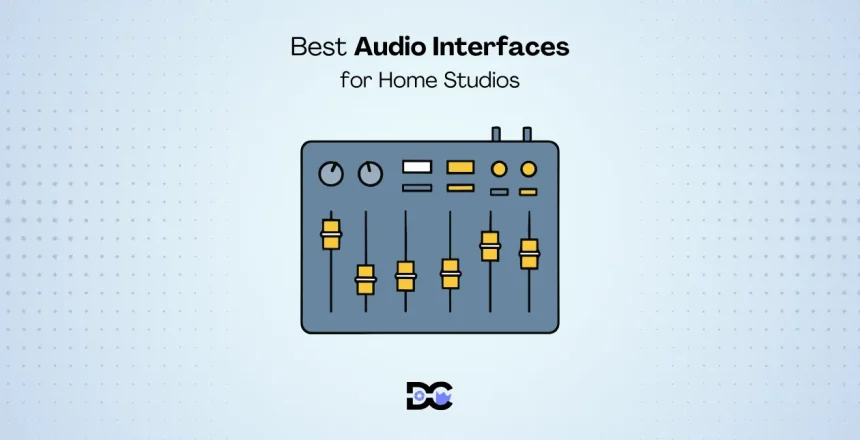Creating high-quality audio at home is now within reach for everyone, thanks to advancements in technology and the growth of content creation in areas like podcasting, streaming, and music production. At the heart of this accessibility is the audio interface— a device that converts signals from microphones or instruments into a digital format for your computer.
For many beginners, relying on a standard computer sound card results in latency, noise, and limited inputs, which can make recordings sound flat and unprofessional. An audio interface solves these issues by offering superior preamps, low-latency performance, and the ability to handle multiple instruments at once.
The global audio interface market, worth $187.59 million in 2024, is expected to grow to $349.79 million by 2032, driven by the demand for professional sound in home setups. USB interfaces lead the market for their convenience, with musicians being the largest user group. Choosing the right audio interface can transform your home studio, ensuring technical limitations never hold back your creativity.
Considerations When Choosing Audio Interfaces
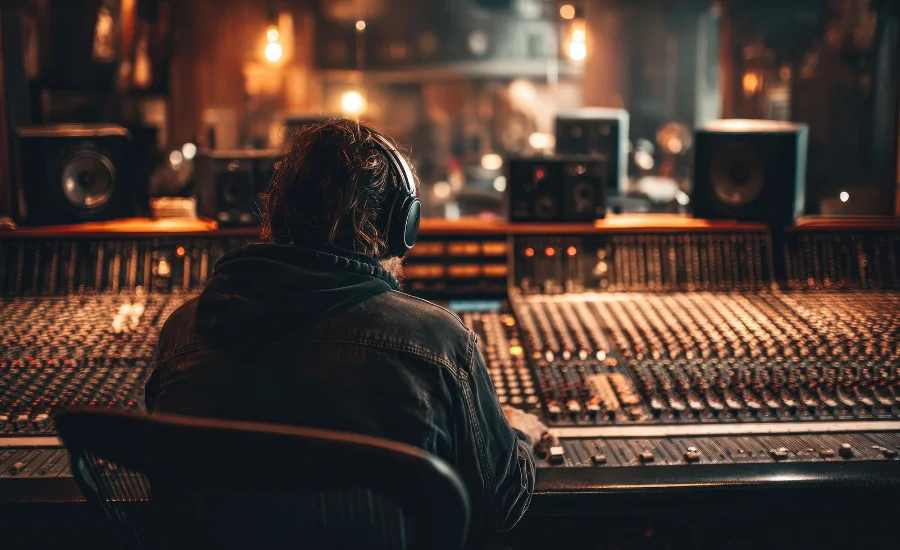
When choosing an audio interface for a home studio, several key factors should be considered to ensure the device meets your specific recording needs.
1. Inputs and Outputs (I/O)
- Number of Channels: Determine how many microphones or instruments you need to record simultaneously. For a single musician or podcaster, a 2-in/2-out interface (like the Focusrite Scarlett 2i2) is often sufficient. If you plan to record a band or multiple sources at once, you will need an interface with more inputs.
- Input Types: Look for the right connectors for your equipment.
- XLR Inputs: Essential for microphones.
- 1/4″ Inputs: Used for instruments like guitars and basses (often a “Hi-Z” input) or line-level signals from keyboards and synthesizers. Many interfaces use “combi” jacks that accept both XLR and 1/4″ cables.
- Outputs: Consider the number of outputs you need for studio monitors, headphones, and other external gear.
2. Preamps and Sound Quality
- Preamps: High-quality preamps are crucial for amplifying microphone and instrument signals cleanly. The quality of the preamps significantly impacts the recording’s sound.
- Phantom Power: If you use condenser microphones, the interface must provide 48V phantom power to operate them.
- Bit Depth and Sample Rate: These specs determine the fidelity of your recordings. A 24-bit/96kHz rate is a standard for professional-grade audio and is sufficient for most home studio applications.
3. Latency and Connectivity
- Low Latency: Latency is the delay between playing a note and hearing it through the interface. A device with low latency is essential for real-time monitoring and prevents timing issues during recording.
- Direct Monitoring: This feature allows you to hear your input signal directly from the interface, bypassing the computer and eliminating any latency.
- Computer Connection: The most common connection types are USB (USB-A, USB-C), Thunderbolt, and FireWire. USB-C and Thunderbolt offer faster data transfer, which helps reduce latency, especially when recording multiple tracks.
4. Portability and Build Quality
- Portability: If you plan to travel or record in different locations, a compact, bus-powered interface (one that draws power from the computer’s USB port) is a practical choice.
- Build: A solid metal chassis and durable knobs are signs of good build quality, which ensures the device can withstand regular use.
5. Bundled Software and Compatibility
- Included Software: Many audio interfaces come with a “lite” version of a Digital Audio Workstation (DAW) or a selection of plugins. This can be a great value for beginners who do not have recording software yet.
- Compatibility: Ensure the interface is compatible with your computer’s operating system (Windows, macOS) and your preferred DAW. Look for products that have dedicated, stable drivers to ensure consistent performance.
Best Popular Audio Interfaces for Home Studios
| Name | Key Features | Starting Price |
| Focusrite Scarlett 2i2 (4th Gen) | Auto Gain, Clip Safe, Air Mode, 2x Scarlett preamps | ₹24,790 |
| Universal Audio Volt 2 | Vintage Mic Preamp Mode, 2x XLR/TRS combo inputs, MIDI I/O | ₹23,256 |
| Audient iD4 MkII | Audient Console Mic Pre, ScrollControl, Dual Headphone Outputs | ₹17,990 |
| SSL 2+ | Legacy 4K Mode, MIDI I/O, two headphone outputs, professional software bundle | $299.99 |
| PreSonus AudioBox USB 96 | 24-bit/96 kHz converters, XMAX mic preamps, compact design | ₹11,990 |
| Behringer U-Phoria UMC22 | Midas-designed preamp, 48 kHz resolution, USB bus-powered | Budget-friendly option, check local retailers |
| Arturia MiniFuse 2 | USB-A Hub, 2x Combo XLR/1/4″ inputs, MIDI I/O, software suite | ₹13,990 |
| Universal Audio Apollo Twin Duo | UAD-2 DUO Core Processor, Thunderbolt connectivity, included software plugins | $1,199.00 |
| RME Babyface Pro FS | TotalMix FX software, stand-alone operation, high-quality preamps | $999.00 |
| M-Audio M-Track Duo | Crystal Preamps, 2x Combo inputs, included software bundle, bus-powered | ₹7,268 |
Focusrite Scarlett 2i2 (4th Gen)
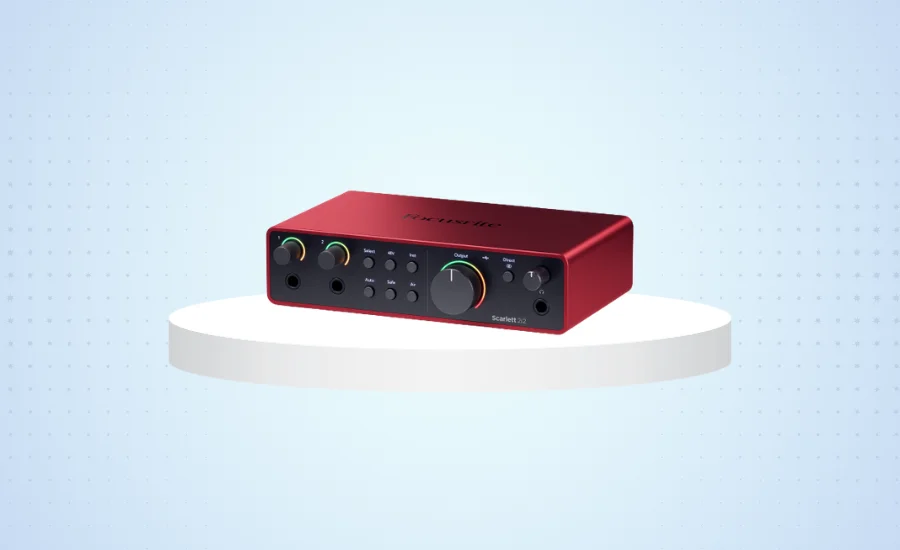
The Focusrite Scarlett 2i2 is a popular choice among home studio creators and is renowned for its reliability. The 4th Gen model enhances its capabilities with new features. It’s a 2-in/2-out USB audio interface that provides high-quality sound for recording vocals, instruments, and more.
A standout feature is the re-engineered Air mode, which offers both ‘Presence’ for high-end sparkle and ‘Harmonic Drive’ for mid-range warmth. This allows you to add a unique character to your recordings right at the source.
The interface also includes innovative beginner-friendly features like Auto Gain and Clip Safe, which automatically adjust levels to prevent clipping, ensuring a clean take every time.
Key Features:
- Auto Gain and Clip Safe for perfect levels
- Two re-engineered Air modes (Presence and Harmonic Drive)
- High-quality preamps and converters
- Includes a generous software bundle
Starting Price: ₹24,790
Universal Audio Volt 2
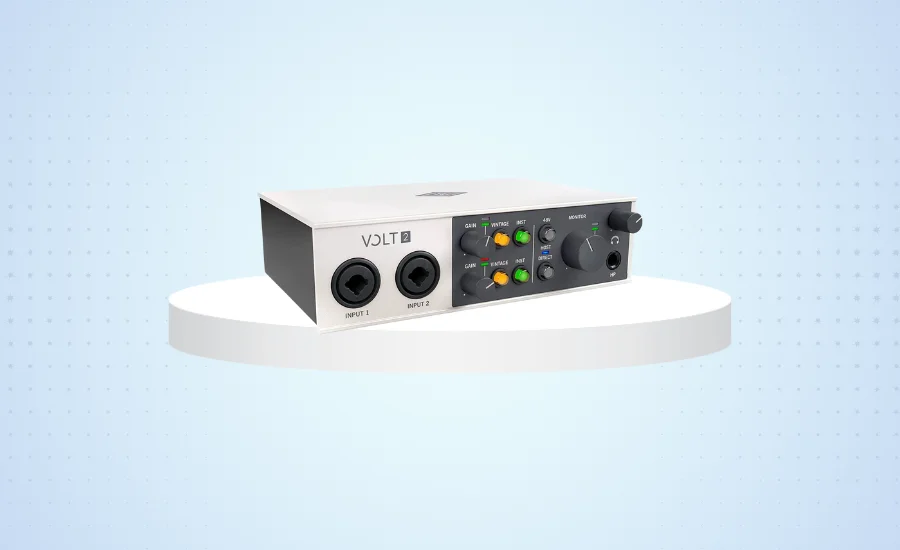
Universal Audio, a brand known for its high-end studio gear, brings its signature sound to the home studio with the Volt 2. This interface stands out with its Vintage Mic Preamp Mode, a feature that emulates the classic sound of the Universal Audio 610 tube preamp used on countless hit records.
This feature adds a rich, analog character to your vocals and instruments. The Volt 2 is a stylish, durable device designed for both home and mobile recording. It provides a 2-in/2-out setup, ensuring superior sound quality and professional results.
Key Features:
- Vintage Mic Preamp Mode with tube emulation
- 24-bit/192kHz audio conversion
- Includes a bundle of professional audio software
- Designed with a rugged, classic build
Starting Price: ₹23,256
Audient iD4 MkII
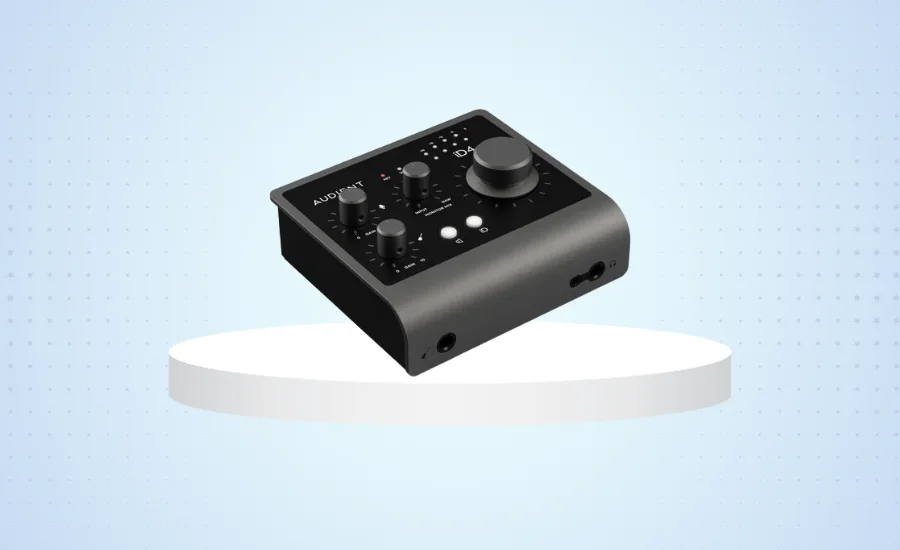
Audient is well-regarded for its high-quality console preamps, and the iD4 MkII brings that professional studio sound to a compact, desktop format.
This 2-in/2-out interface features a single Audient Console mic pre, which delivers a clean signal with low noise and distortion. A unique feature is the “ScrollControl” mode, which turns the volume knob into a virtual scroll wheel, allowing you to control compatible on-screen parameters in your software.
The device also offers dual headphone outputs, making it ideal for collaborative sessions. It is bus-powered and compatible with iOS devices, providing flexibility for recording anywhere.
Key Features:
- Audient Console Mic Preamp
- Class-leading converters
- “ScrollControl” for software control
- Dual headphone outputs
Starting Price: ₹17,990
SSL 2+
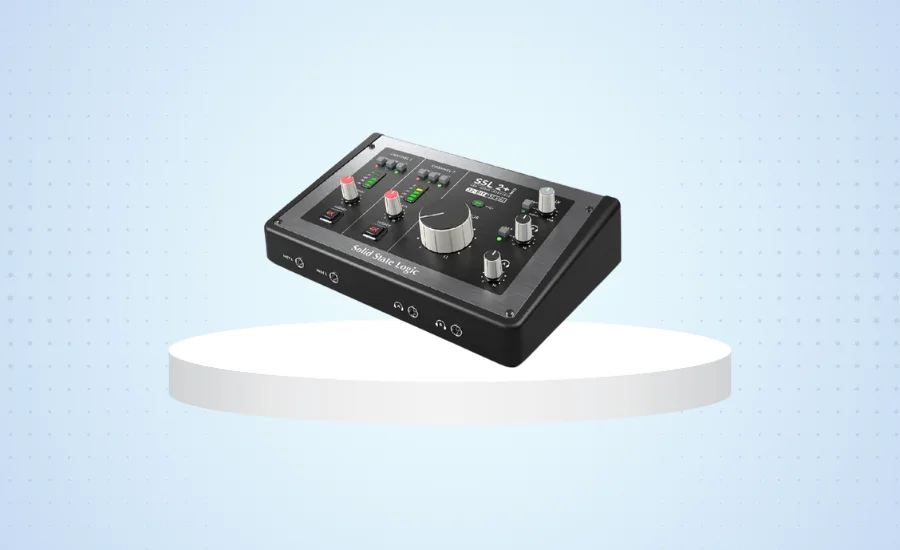
Solid State Logic (SSL) has been at the forefront of music production for decades, with its consoles found in world-class studios. The SSL 2+ brings that legacy to a more accessible price point.
This 2-in/4-out USB interface features two high-quality mic preamps and a unique “Legacy 4K” button on each channel.
This button adds a high-frequency boost and subtle harmonic distortion, emulating the classic sound of SSL’s 4000 series consoles. The SSL 2+ also provides two headphone outputs, making it perfect for collaboration, and includes a professional software bundle to get you started.
Key Features:
- Legacy 4K button for classic SSL console sound
- High-quality SSL preamps
- Two headphone outputs and MIDI I/O
- Comes with a substantial software suite
Starting Price: $299.99
PreSonus AudioBox USB 96
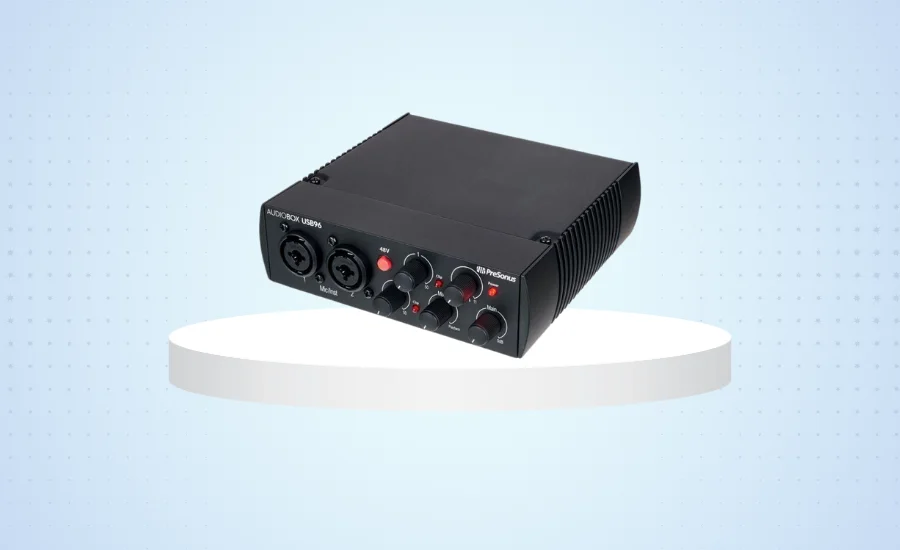
The PreSonus AudioBox USB 96 is a simple and reliable audio interface that has been a go-to for many beginners for years. It is a 2-in/2-out device with two combo mic/instrument inputs and high-quality XMAX preamps.
The interface operates at a resolution of up to 24-bit/96 kHz, ensuring clean and professional recordings. Its straightforward design, rugged build, and USB bus-powered operation make it highly portable and easy to use.
The AudioBox USB 96 often comes bundled with PreSonus’s own Studio One Artist DAW, providing a complete package for starting your music production journey.
Key Features:
- High-quality XMAX preamps
- 24-bit/96 kHz resolution
- Compact and durable metal chassis
- Often includes PreSonus Studio One Artist DAW
Starting Price: ₹11,990
Behringer U-Phoria UMC22
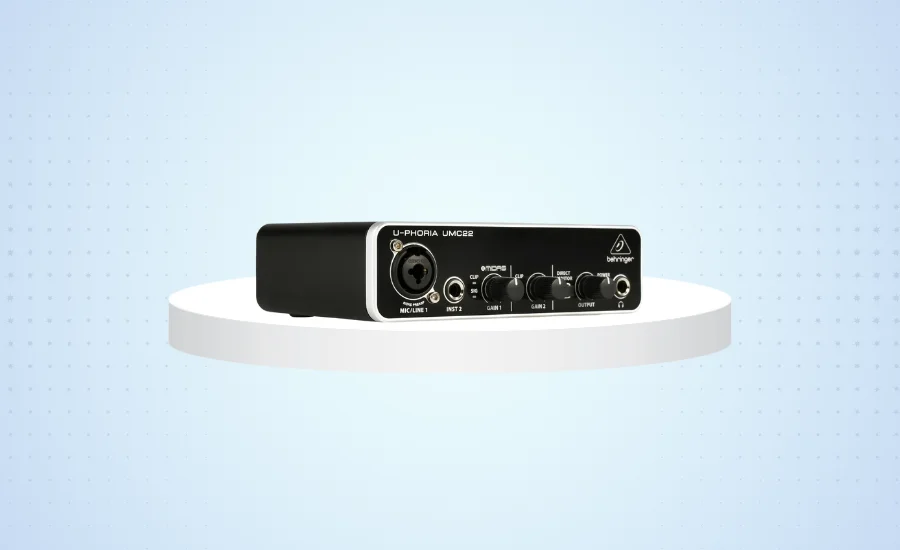
The Behringer U-Phoria UMC22 is a highly budget-friendly option that doesn’t compromise on core performance. This 2-in/2-out USB interface features a Midas-designed mic preamp, a brand well-known for its quality mixing consoles.
While it has a slightly lower sample rate of 48 kHz compared to some competitors, it is still more than sufficient for high-quality podcasting, voiceovers, and home demos.
It has one XLR/TRS combo input and one dedicated instrument input, making it versatile for single-person recording setups. Its simple design and reliable performance make it a great entry point for those on a tight budget.
Key Features:
- Midas-designed mic preamp
- 48 kHz resolution
- Direct monitoring for zero-latency recording
- Rugged metal chassis
Starting Price: Check local retailers
Arturia MiniFuse 2
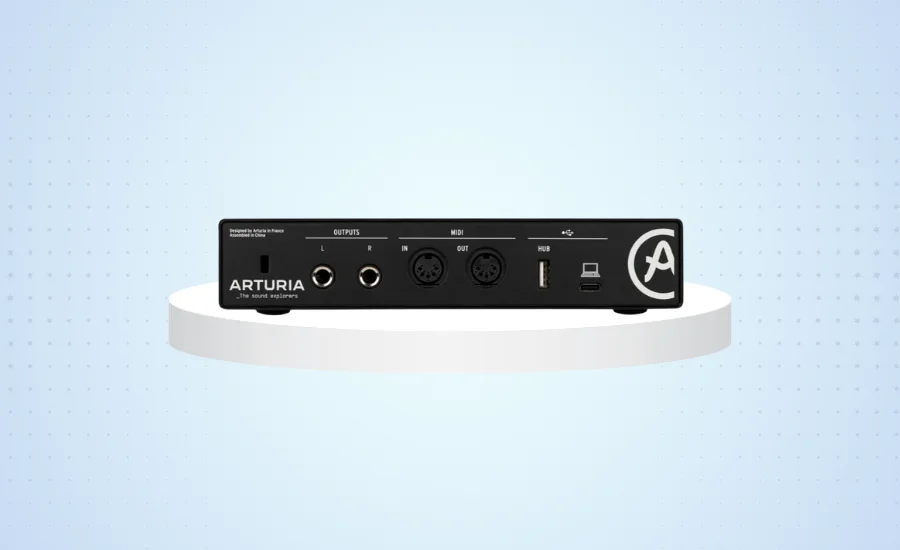
Arturia, a company with a strong reputation for innovative hardware and software, designed the MiniFuse 2 to be a smart and connected audio interface. It offers a 2-in/2-out setup with high-quality preamps and a rugged aluminum casing that is perfect for musicians on the go.
One of its standout features is the built-in USB hub, which allows you to connect a MIDI controller or other USB device directly to the interface, freeing up a port on your computer.
It also comes with a comprehensive software bundle, including Arturia’s own Analog Lab Intro and a suite of creative effects.
Key Features:
- Built-in USB-A hub
- High-quality preamps with a low noise floor
- Includes a powerful software suite
- Compact and durable aluminum build
Starting Price: ₹13,990
Universal Audio Apollo Twin Duo
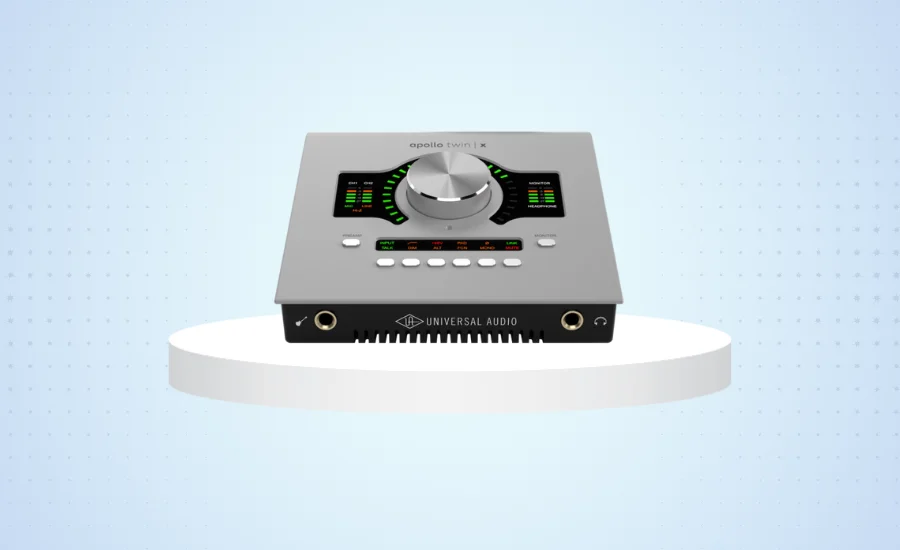
The Universal Audio Apollo Twin Duo is a premium audio interface for serious home studio producers. Its main selling point is the onboard UAD-2 DUO Core Processor, which allows you to run Universal Audio’s UAD plugins in real-time without straining your computer’s CPU.
This is a game-changer for recording with studio-grade effects like compressors and EQs. With its Thunderbolt connectivity, it offers incredibly low latency and high-quality conversion at 24-bit/192kHz.
It is an investment, but for those who want to use a wide range of top-tier plugins and get the best possible sound, the Apollo Twin is an excellent choice.
Key Features:
- Onboard UAD-2 DUO Core DSP
- Thunderbolt 3 connectivity for ultra-low latency
- Real-time UAD plugin processing
- Includes a collection of professional plugins
Starting Price: $1,199.00
RME Babyface Pro FS
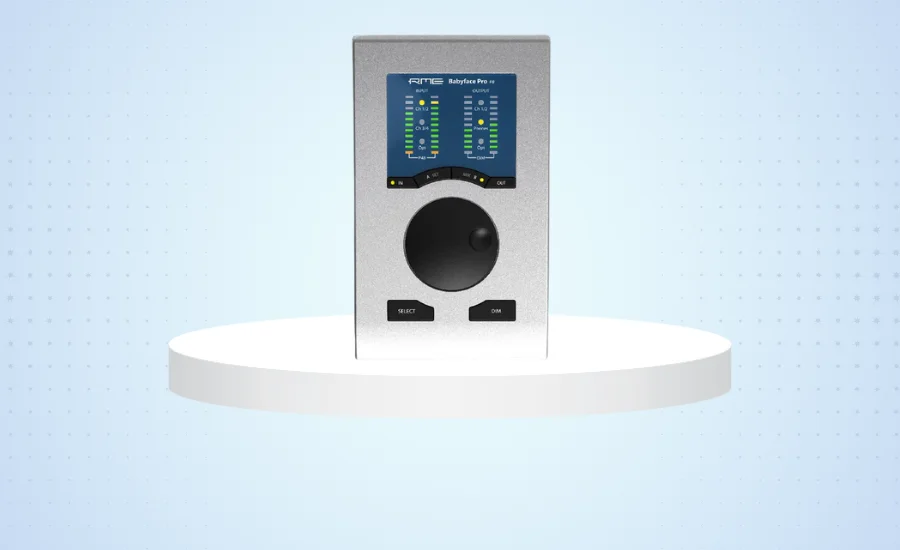
The RME Babyface Pro FS is a top-tier portable audio interface known for its exceptional sound quality and professional features. It’s a 24-channel USB interface with two high-quality preamps and an improved “SteadyClock FS” circuit for jitter reduction.
One of its most powerful features is the TotalMix FX software, which provides a comprehensive digital mixer, allowing for complex routing and effects processing directly on the interface itself.
It’s incredibly versatile and can even run in standalone mode without a computer. The Babyface Pro FS is a premium choice for audio professionals and serious enthusiasts who require uncompromising performance.
Key Features:
- SteadyClock FS for pristine audio
- TotalMix FX software for advanced routing
- Stand-alone operation
- High-quality converters and preamps
Starting Price: $999.00
M-Audio M-Track Duo
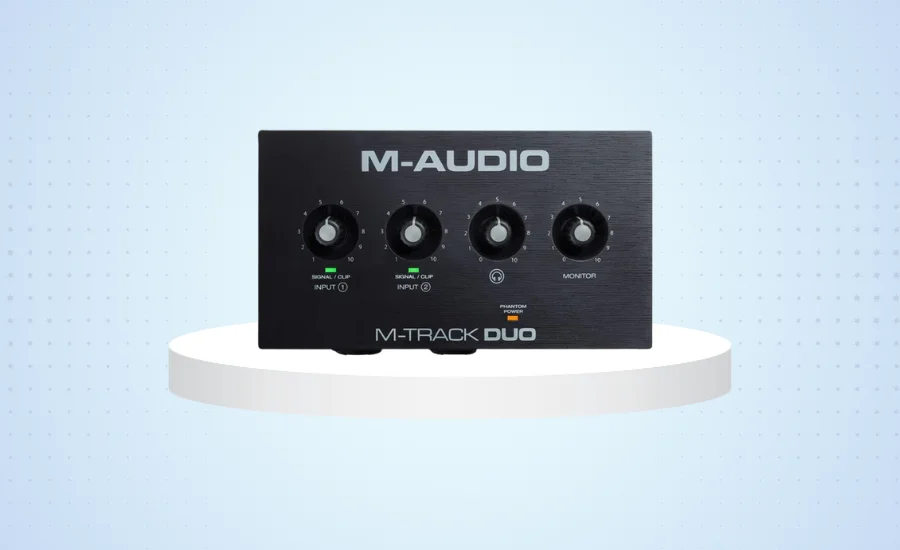
The M-Audio M-Track Duo is another excellent option for those looking for a simple and affordable entry into home recording. It features two combo inputs with M-Audio’s “Crystal Preamps” that deliver transparent and low-noise recordings.
This bus-powered interface is compact and easy to set up, making it ideal for beginners. It also includes a software bundle with Pro Tools | First and Ableton Live Lite, giving new creators a solid foundation for their projects.
The M-Track Duo offers great value for money, providing all the basic features needed to start recording with a microphone and an instrument.
Key Features:
- Crystal Preamps for clean audio
- Bus-powered for portability
- Direct monitoring for zero-latency recording
- Includes a software package with Pro Tools | First
Starting Price: ₹7,268
FAQs
What is an audio interface and why is it essential for a home studio?
An audio interface is a device that connects your microphones and instruments to your computer. It is essential because it converts the analog audio signals into a digital format your computer can understand with much higher quality than a standard built-in sound card, while also providing crucial features like low-latency monitoring and professional inputs.
What is latency, and how does an audio interface help reduce it?
Latency is the small but noticeable delay between playing a note or speaking into a microphone and hearing it back through your headphones or speakers. An audio interface uses dedicated drivers to bypass your computer’s native sound processing, allowing for near-instantaneous, real-time monitoring of your performance as you record.
What is the benefit of the Vintage Preamp Mode on the Universal Audio Volt 2?
The Vintage Preamp Mode on the Universal Audio Volt 2 is a feature that emulates the sound of the classic Universal Audio 610 tube preamp. This adds a rich, harmonic warmth to your audio signals, giving them an authentic, professional analog character.
What is the SSL 2+’s “Legacy 4K” mode, and what does it do?
The “Legacy 4K” mode on the SSL 2+ is a special circuit that, with the press of a button, adds a high-frequency boost and subtle harmonic distortion to your audio. This feature is inspired by the legendary Solid State Logic 4000 series consoles, helping your sound stand out in the mix.
What is the purpose of the “ScrollControl” feature on the Audient iD4 MkII?
The “ScrollControl” feature on the Audient iD4 MkII allows you to use the interface’s large volume knob as a virtual scroll wheel for your computer. This enables you to control various on-screen parameters in your digital audio workstation (DAW) or plugins, such as faders or knob settings, making your workflow faster and more intuitive.
Do I need to buy extra software with an audio interface?
No, most modern audio interfaces, including many on our list, come bundled with a powerful software package. This typically includes a digital audio workstation (DAW) like Ableton Live Lite or Pro Tools, as well as a variety of plugins, virtual instruments, and effects to help you start recording and producing immediately.
Is a bus-powered audio interface a good option?
Yes, a bus-powered audio interface is an excellent option for home studios, especially for those who need to record on the go. It draws all the necessary power directly from your computer’s USB port, eliminating the need for a separate power adapter and making your setup more portable and clutter-free.
What’s the difference between a 2-input and a multi-input interface?
A 2-input interface is ideal for single-person recording setups, such as recording vocals with a single microphone and an instrument simultaneously. A multi-input interface, with more than two inputs, is necessary if you need to record a full band, a drum kit with multiple microphones, or multiple instruments at the same time.
Conclusion
Choosing the right audio interface is a crucial step in building a successful home studio. It is the central piece of hardware that determines the quality of your recordings. As we have seen, the market offers a wide range of options, from budget-friendly devices like the M-Audio M-Track Duo and Behringer U-Phoria UMC22 that provide a solid entry point, to mid-range powerhouses like the Focusrite Scarlett 2i2 and Arturia MiniFuse 2 that offer a blend of features and value. For those who are ready to make a significant investment in their craft, premium interfaces like the Universal Audio Apollo Twin Duo and RME Babyface Pro FS provide world-class sound and powerful DSP processing that can elevate your production to the highest professional level.
Ultimately, the best audio interface for you depends on your specific needs, budget, and creative goals. By understanding the core features—such as preamps, converters, and connectivity—you can make an informed decision and invest in a tool that will enable you to create professional-quality audio from your own space. With the right gear, your creative vision can finally be heard with the clarity and quality it deserves.
